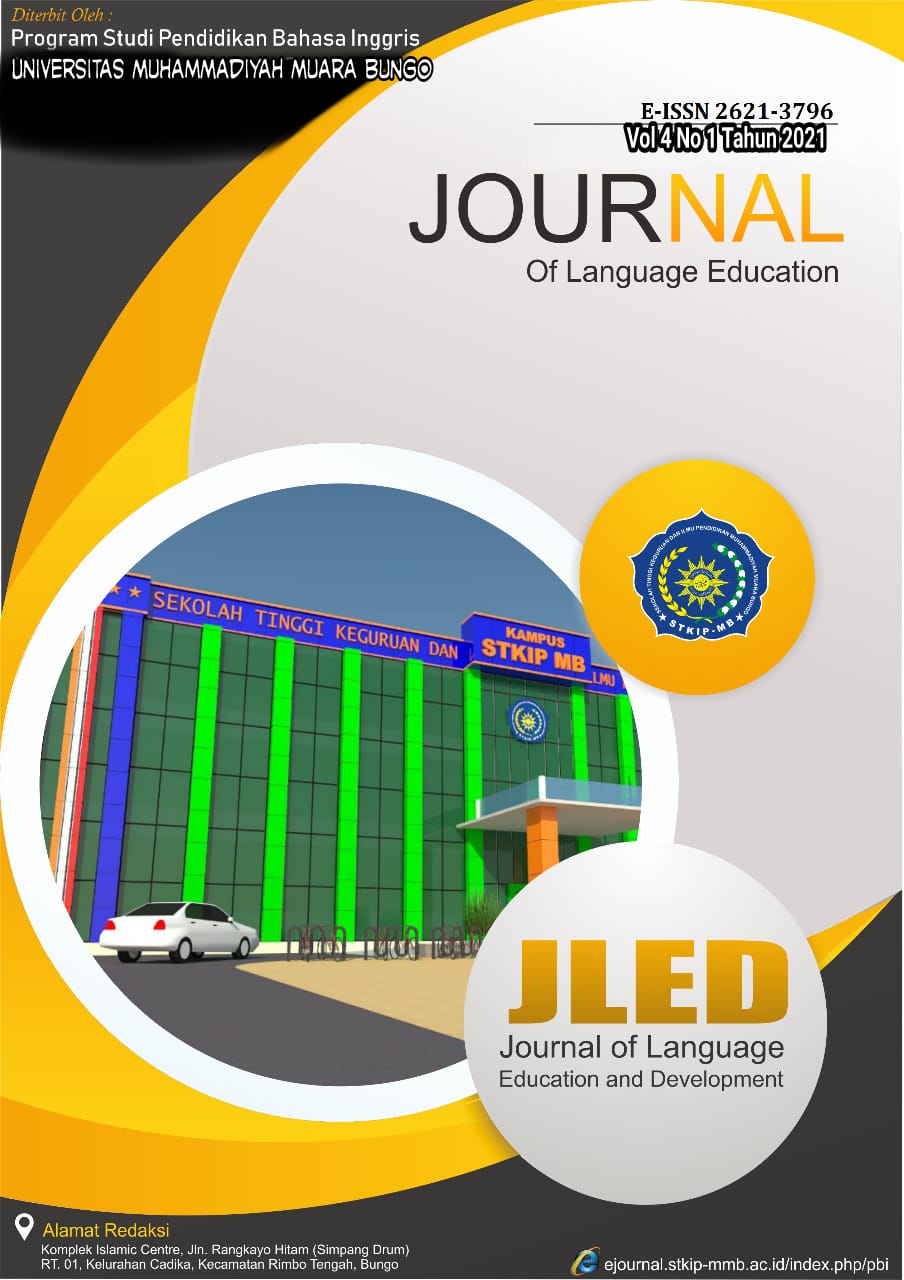A Case Study: Student’s Anxiety in Learning English at the 7th Grade of SMP Negeri 3 Muara Bungo
Abstract
This study was carried out to investigate foreign language anxiety of EFL junior secondary school students at the 7th grade of SMPN 3 Muara Bungo. Specifically, it sought to identify what factors that may contribute to anxiety in English learning environment based on the students’ perspectives. The method was used in this study was qualitative method with case study approach. Fifteen anxious students were selected as the participants. The data were gathered through structured interviews and classroom observations. The result of the study showed that speaking in front of the class, being laughed at by others, incomprehensible input, students’ beliefs about language learning, teacher personality, and lack of preparation were the six factors that may contribute to the students’ anxiety in learning English.
References
Brown, H. Douglas. 1991. Breaking the Language Barrier. Yarmouth: Intercultural Press, Inc.
Bungin, Burhan. 2007. Penelitian Kualitatif. Jakarta: Kencana Predana Media Group.
Carlson, Neil R., and William, Buskist. 1997. Psychology: The Science of Behavior. Needham Heights: Viacom Company.
Chan, D. Y., and Wu, G. 2004. A Study of Foreign Language Anxiety of EFL Elementary School Students in Taipei Country, Journal of National Taipei Teachers College, Vol. 17.
Creswell, J.W. 2012. Educational Research: Planning, Conducting, and Evaluating Quantitative and Qualitative Research, Fourth Edition. Boston: Pearson Education, Inc.
Fraenkel, J. R., and Wallen, N. E. 2009. How to Design and Evaluate Research in Education: Seventh Edition. New York: The McGraw-Hill Companies,
Halgin, Richard P., and Susan, Krauss W. 2007. Abnormal Psychology: Clinical Perspectives on Psychological Disorders. New York: McGraw-Hill.
Horwitz, E. K., et. al., 1986. Foreign Language Anxiety, The Modern Language Journal. Vol. 70.
Horwitz, E. K. and Dolly, J. Young. 1991. Language Anxiety: from Theory and Research to Classroom Implications. New Jersey: Prentice-Hall Inc.
Iizuka, Keiko. 2010. Learner Coping Strategies for Foreign Language Anxiety, JALT2009 Conference Proceedings.
Marwan, Ardi. 2007. Investigating Students’ Foreign Language Anxiety, Malaysian Journal of ELT Research. Vol. 3.
Ormrod, J. E. 2011. Educational Psychology: Developing Learner. Boston: Pearson Education Inc.
Passer, Michael W., and Ronald E., Smith. 2009. Psychology: The Science of Mind and Behavior. New York: McGraw-Hill.
Schutz, Ricardo. “Stephen Krashen’s Theory of Second Language Acquisition”, http://www.sk.com.br/sk-krash.html, 30th November 2013.
The National Science Foundation, “Analyzing Qualitative Data”, http://www.nsf.gov/pubs/ 1997/nsf97153/chap_4.htm, 2013.
Williams, K. E., and Andrade, M. R. 2008. Foreign Language Learning Anxiety in Japanese EFL University Classes: Causes, Coping and Locus of Control, Electronic Journal of Foreign Language Teaching. Vol. 5 No. 2.
Worde, R. V., 2003. Students’ Perspectives on Foreign Language Anxiety, Inquiry. Vol. 8 No. 3.
Wrench, Jason S., et. al. 2014. “What is Communication Apprehension?”, www. 2012books.lardbucket.org/books/public-speaking-practice-and-ethics/s06-01-what-is-communication-apprehen.html,
Young, D. J. 1999.Affect in Foreign Language and Second Language Learning: a Preactical Guide to Creating a Low-Anxiety Classroom Atmosphere. Boston: McGraw-Hill.
| Keywords | : |
Keywords:
Students’ Anxiety, English
|
| Galleys | : | |
| Published | : |
2022-08-10
|
| How to Cite | : |
Fatmawati, F. (2022). A Case Study: Student’s Anxiety in Learning English at the 7th Grade of SMP Negeri 3 Muara Bungo. Journal Of Language Education and Development (JLed), 4(1), 38–43. https://doi.org/10.52060/jled.v3i2.829
|
| Issue | : |









2.png)
1.png)
